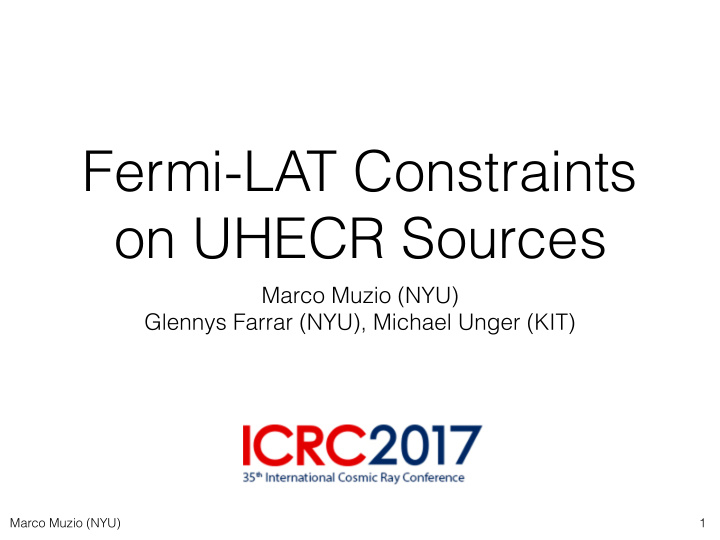



Fermi-LAT Constraints on UHECR Sources Marco Muzio (NYU) Glennys Farrar (NYU), Michael Unger (KIT) Marco Muzio (NYU) 1
Motivation • Liu et al. (2016) argued that there must be a “local fog” of UHECR sources (cf. Taylor highlight talk) • Used IGRB limits on diffuse photon fluxes Liu, et al., Phys. Rev. D 94 , 043008 (2016) • Considered a pure-proton scenario • Could a mixed-composition scenario evade the IGRB limits without such a fog? • YES! Marco Muzio (NYU) 2
UFA Source Model M. Unger, G.R. Farrar & L.A. Anchordoqui, Phys. Rev. D 92 (2015) 123001, arXiv:1505.02153 • UFA model explains the origin of ankle and light composition at EeV energies • Does so by taking into account photonuclear reactions in source environment source environment EBL/CMB detection e+ e- cosmic ray 𝛿 Marco Muzio (NYU) 3
UFA models give excellent fit to flux and composition Composition at Earth Flux at Earth Escaping flux from source UFA fiducial model Marco Muzio (NYU) 4
Goal of CRtoEM • Use Fermi-LAT data to constrain UHECR Source model viable CR source models dN/dE, dN/dz, composition • Specify UHECR source model • Injection spectrum and composition • Source evolution CRtoEM • Create an efficient way to obtain the observed flux of CRs and EM particles predicted by various source models with high statistical quality E 2 dN/dE • Avoid redundant calculations! E Marco Muzio (NYU) 5
Methodology Z, A • Average observed flux of CRs, EM particles due to CR propagation depends on only: • Particle type • Initial particle energy E i • Initial distance from observer • Method: D j • Tabulate the average fluxes due to CRs E 2 dN/dE E 2 dN/dE of a given type, energy, and distance • Bin in energy and comoving distance CRs • Weight these fluxes to reflect a given Photons source model E E Marco Muzio (NYU) 6
Building CRtoEM • Tabulated fluxes based on CRPropa3 and ELMAG • Calculation is done in 3 parts: • CRPropa3 is used to propagate CRs • Observed CR flux (a) • Distribution of EM primary secondaries (b) • ELMAG is used to cascade EM particles • Observed flux of photons and e+/-’s (c) • Parameter space: 17 20 • Primary secondary distribution and • CR: 0-6520 Mpc, 10 -10 eV observed EM fluxes are combined to 8 20 • EM: 0-6520 Mpc, 10 -10 eV obtain observed EM flux due to CRs • 10 bins per decade of energy Marco Muzio (NYU) 7 • 20 Mpc wide bins in comoving distance
Pure proton model with uniform evolution is in tension with Fermi-LAT Note that pure proton model can fit spectrum, but not composition Marco Muzio (NYU) 8
Pure proton model with SFR evolution is in conflict with Fermi-LAT Note that pure proton model can fit spectrum, but not composition Marco Muzio (NYU) 9
Mixed Composition (UFA fiducial) with SFR evolution is consistent with Fermi-LAT Note that UFA fiducial model can fit spectrum and composition Marco Muzio (NYU) 10
Realistic, mixed composition UHECR model is not in conflict with Fermi-LAT • The UFA predicted photon flux is compatible with IGRB limits • A more realistic mixed- composition scenario evades IGRB limits even with a SFR evolution UFA • Other UFA source scenarios ~87% of limit may further reduce the Fermi- LAT gamma-ray flux Marco Muzio (NYU) 11
(Sensitivity to Redshift Cutoff) • 50 GeV energy bin is not particularly sensitive to high redshifts in uniform or SFR evolution scenarios Uniform SFR Marco Muzio (NYU) 12
Summary • UFA-like scenarios are able to recreate the Auger spectrum and avoid photon flux limits even for SFR evolution* • The need for a local fog of UHECR sources evaporates in mixed-composition scenarios UFA Future: Explore sensitivity of gamma ray flux to source evolution and environment assumptions * see also Globus talk @ 1:45 today Marco Muzio (NYU) 13
Recommend
More recommend